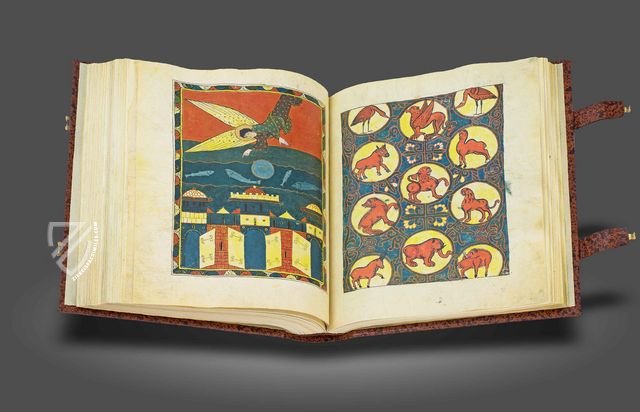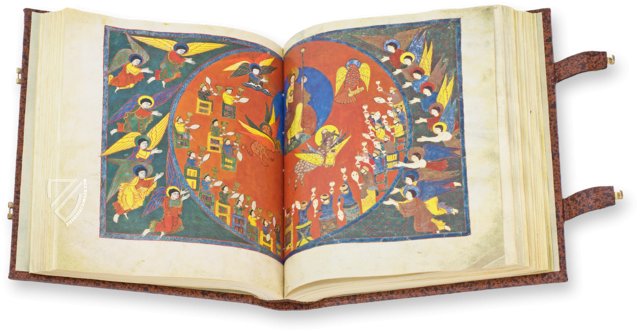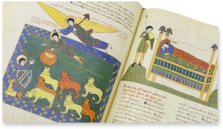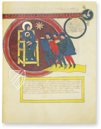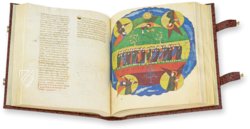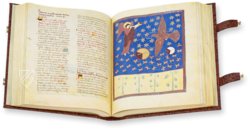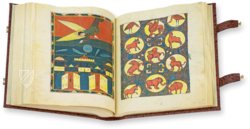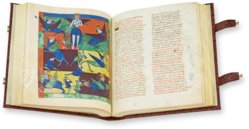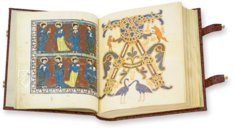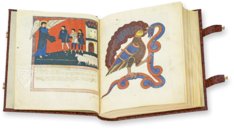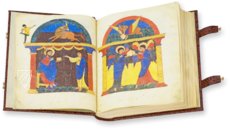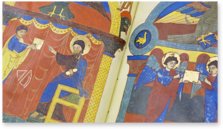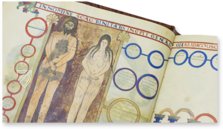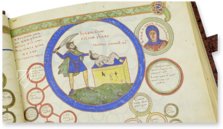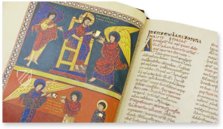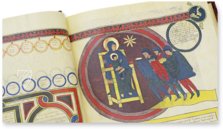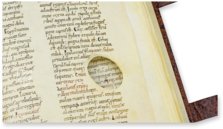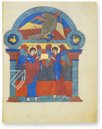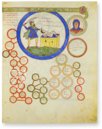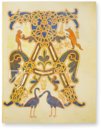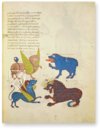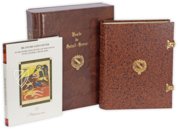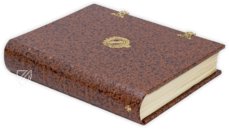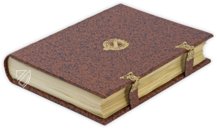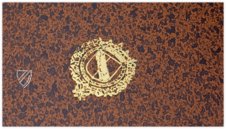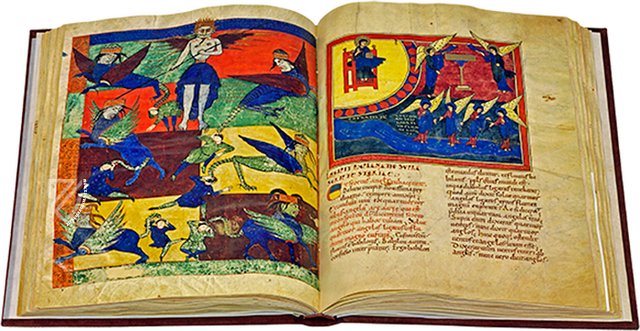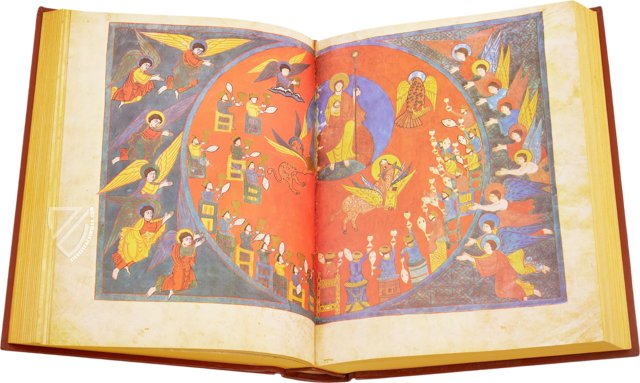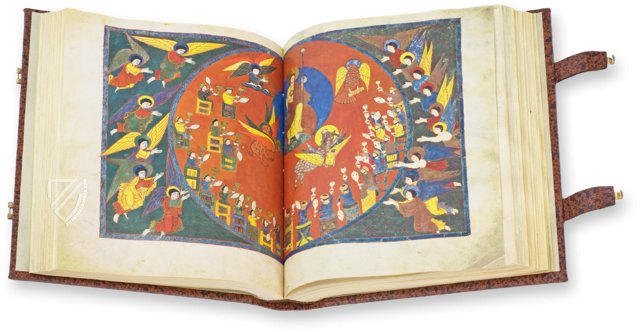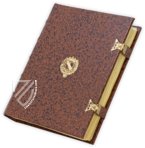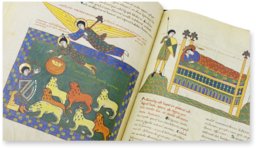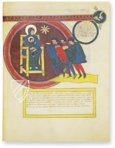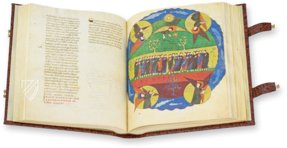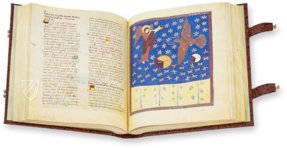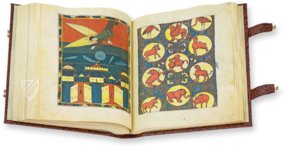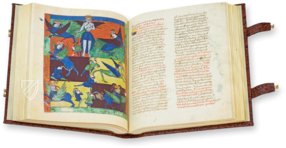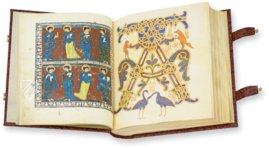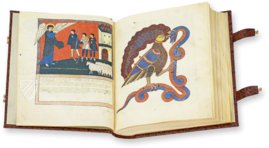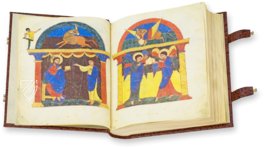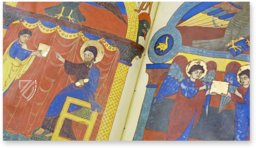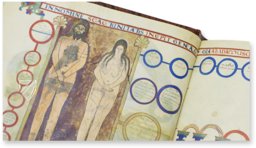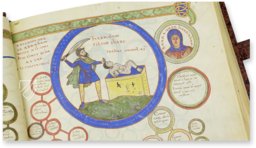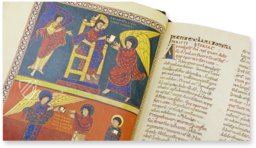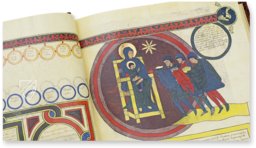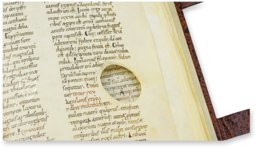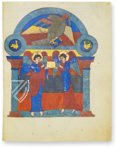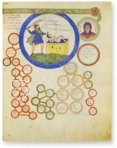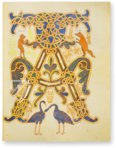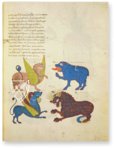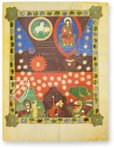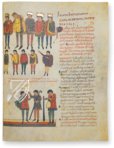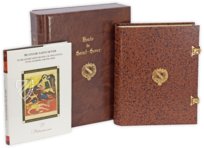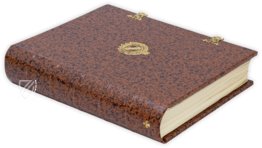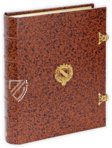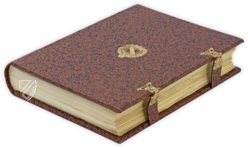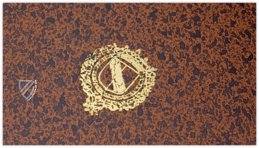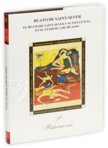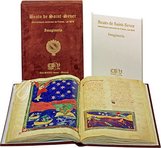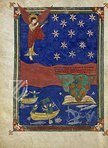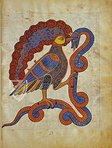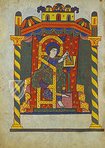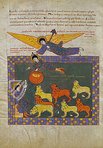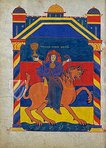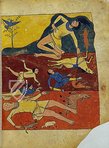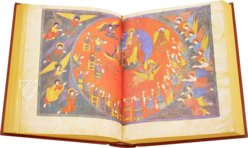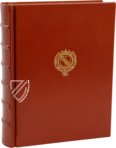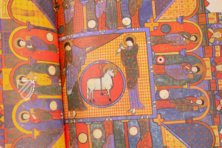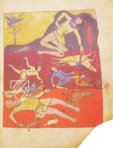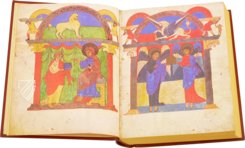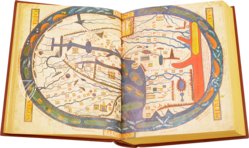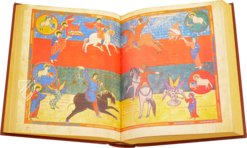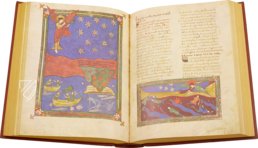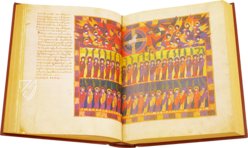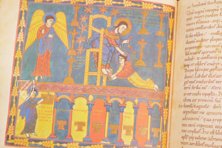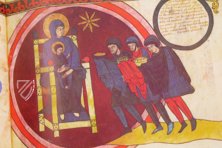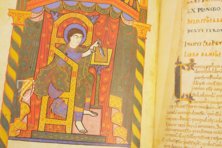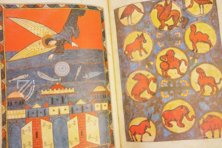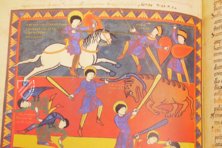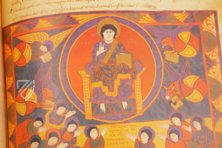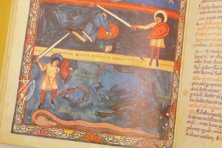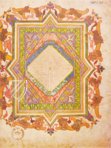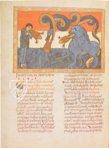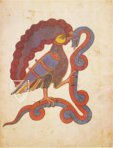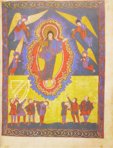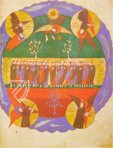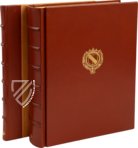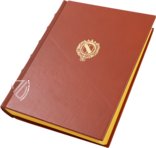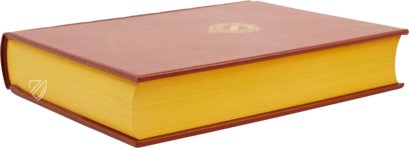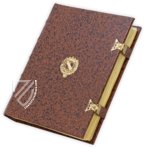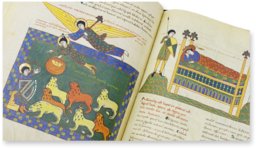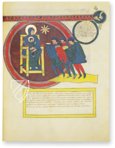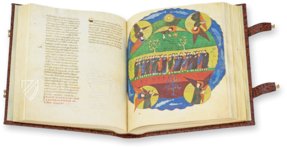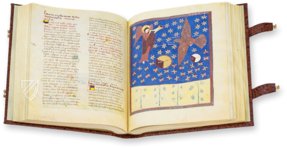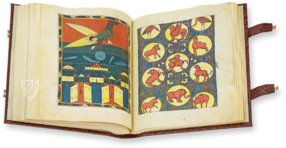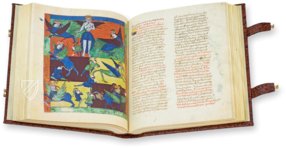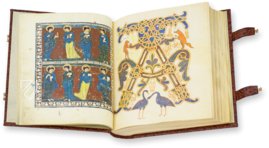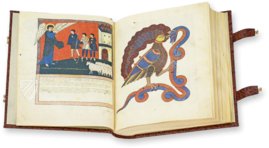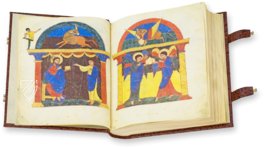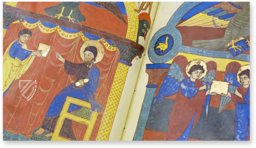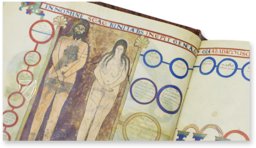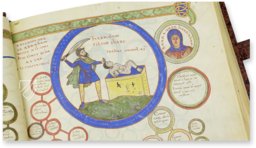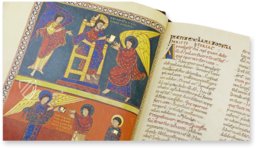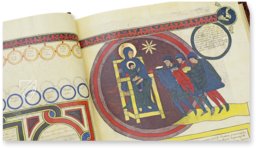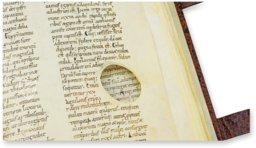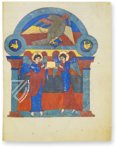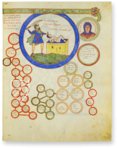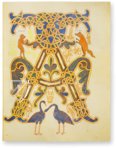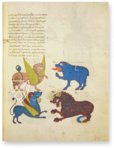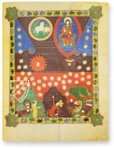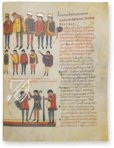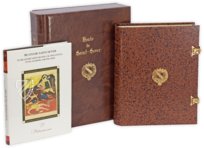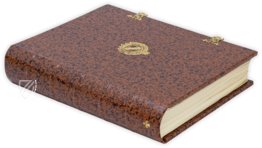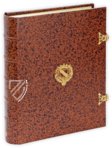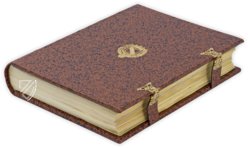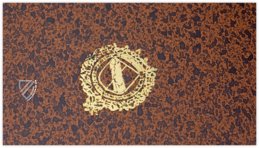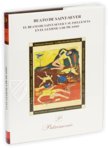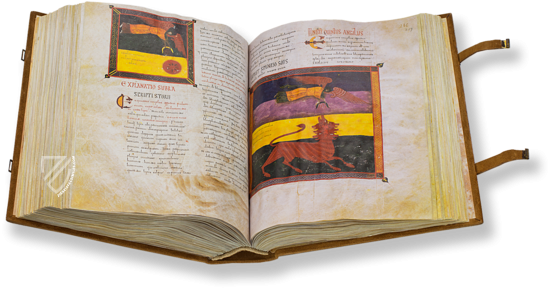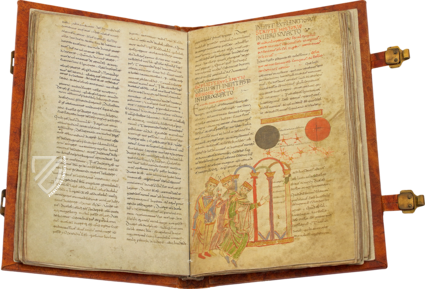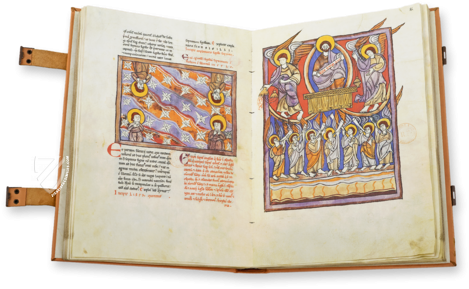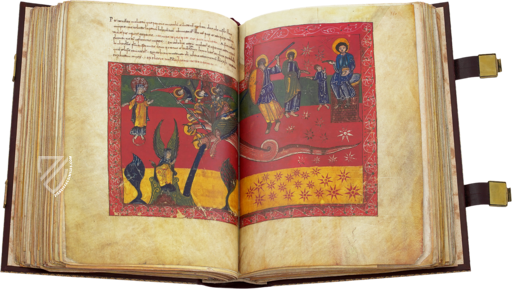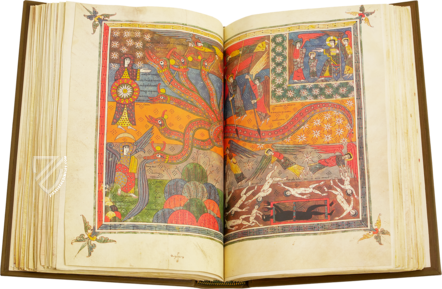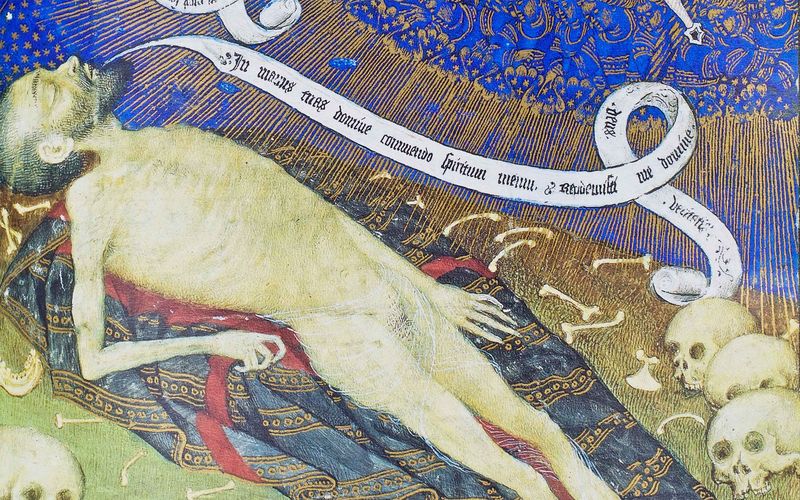Beatus of Liébana - Saint-Sever Codex
(3,000€ - 7,000€)
The Beatus of Liébana - Saint-Sever Codex is counted among the highlights of 11th century French illumination and is one of the all-time most grandiose works of illumination. The 112 miniatures, some of them even double-page, and the over 1,400 colored initials of the nearly 600-page text are amazing. The codex contains the Apocalypse commentary by the Asturian monk Beatus of Liébana as well as expositions on the Evangelists and their writing, a genealogy of Christ, and St. Jerome’s commentary of the Book on Daniel. Aside from the overwhelming visual adornment illustrating the fascinating Book of Revelation concerning the end of the world, above all it is the fact the Saint-Sever Beatus represents the only French Beatus manuscript that makes the codex so unique.
Beatus of Liébana - Saint-Sever Codex
The Saint-Sever Codex of the famous Beatus Apocalypse Commentary is counted among the highpoints of 11th century French illumination and the most grandiose works of illumination of all time. The 112 miniatures, some of them even double-sided, and over 1,400 colored initials of the text amaze on nearly 600 pages. The codex contains the famous Apocalypse commentary by the Asturian monk Beatus of Liébana in addition to expositions on the Evangelists and their writing, a genealogy of Christ, and St. Jerome’s commentary on the Book of Daniel. Aside from the overwhelming pictorial adornment illustrating the fascinating Revelation of St. John about the end of the world, above all it is the fact the Saint-Sever Beatus represents the only French Beatus manuscript that makes the codex so unique.
Beatus of Liébana’s Magnum Opus
The primary work of the Asturian monk Beatus of Liébana was popular in the Middle Ages, especially in northern Spain. Beatus of Liébana was a monk and theologian in a monastery in the Kingdom of Asturias in the north of modern Spain. He lived in the 8th century and probably died sometime after 798. He is famous for his magnum opus, the commentary on the Revelation of St. John in twelve books. The text of the Apocalypse was divided into 66 sections, after each of which followed the so-called explanatio, the commentary by Beatus on the verses. The allegorical and symbolic pictures of the Apocalypse were thus meant to be more easily understood. The end of the world was expected in the year 800, causing Beatus to compose his famous Apocalypse commentary. This manuscript from the end of the 8th century was particularly popular in north Spanish illumination during the Middle Ages and survives in 27 richly illuminated manuscripts today.
A Unique French Specimen
Nearly all of these Beatus manuscripts originate from Spain. Thus, the Saint-Sever Codex represents a unique exception, it is nevertheless the only Beatus to originate in France. It was commissioned by Grégoire de Montaner (1028–1072), Abbot of Saint-Sever. The Benedictine monastery was founded as the end of the 10th century and quickly developed into a proud and influential abbey. Under Grégoire de Montaner, Saint-Sever became a center of art and culture, gathering together important sculptors and illuminators. The master of the famous scriptorium of Saint-Sever, Stephanus Gaudus, completed the abbey’s most famous work with the help of a group of copyists and miniaturists from the scriptorium ca. 1038: the Saint-Sever Codex, which is stored today in the Bibliothèque Nationale in Paris.
Fantastic Creatures and Heavenly Events
This splendid codex assembles 112 miniatures and over 1,400 colored initials on 592 pages. The most diverse influences are conveyed in the manuscript’s miniatures. Above all, the relationship to the Spanish Beatus manuscripts is clear, e.g. the page with the depiction of Babylon, surrounded by snakes, just like in other Beatus manuscripts. Yet, knowledge of African, Islamic, Oriental, and Insular art and culture are also recognizable. Ancient or Carolingian illumination clearly influenced the author’s picture in the Book of Daniel. The unbelievable visions of St. John were set against a rich gold background in an unbelievable wealth of colors and forms. The picture pages are furnished with rich ornamentation, e.g. the frontispiece with its vegetal and animal décor, as well as numerous additional carpet pages adorning the book. The compositions of the depictions are impressive, e.g. the miniature of the seventh sign on a double page. Presented there in predominantly luminous shades of red against a gold background are two rows of the chosen, who worship the Lamb of God with palm leaves in their hands. Naturally, there are terrifying pictures of angry angels and mythical creatures with the bodies of grasshoppers and awful grimaces. When immersing oneself into the unbelievable visual world of the Beatus commentary on the Apocalypse by John, it quickly becomes clear that the Saint-Sever Beatus is “one of the most important masterpieces of medieval illumination overall”.
Codicology
- Alternative Titles
- Beatus von Liébana - Codex von Saint-Sever
Beato de Liébana: Códice de Saint-Sever
Beato de Saint-Sever
Saint-Sever Beatus
Apocalypse de Saint-Sever - Size / Format
- 592 pages / 36.7 × 28.6 cm
- Origin
- France
- Date
- Ca. 1038
- Epochs
- Style
- Genre
- Script
- Carolingian minuscule Visigothic
- Illustrations
- 112 miniatures illuminated in gold and more than 1,400 colour initials
- Content
- Beatus of Liébana's Commentary on the Book of Revelation
Saint Jerome's Commentary on the Book of Daniel
St. Ildefonsus of Toledo's "De Virginitate Beatae Mariae"
Charters of Saint-Sever Abbey - Patron
- Gregorio Muntaner, Abbot of Saint-Sever (1028–1072)
- Artist / School
- Beatus of Liébana (died after 798) (author)
Stephanus Garsia and others (illuminators)
Leonese Romanesque - Previous Owners
- Mathurin Brin
Guillaume Guerry
François d’Escoubleau de Sourdis
Charles d’Escoubleau de Sourdis Louis-Jean Gaignat
Antoine-René de Voyer de Paulmy d’Argenson
Jacob-Nicolas Moreau
Beatus of Liébana - Saint-Sever Codex
The Sixth Seal
Kings and other great men seek shelter in caves as God’s wrath rains down on the earth: “I looked when He opened the sixth seal, and behold, there was a great earthquake; and the sun became black as sackcloth of hair, and the moon became like blood. And the stars of heaven fell to the earth, as a fig tree drops its late figs when it is shaken by a mighty wind. Then the sky receded as a scroll when it is rolled up, and every mountain and island was moved out of its place.” (Rev. 6:12-14)
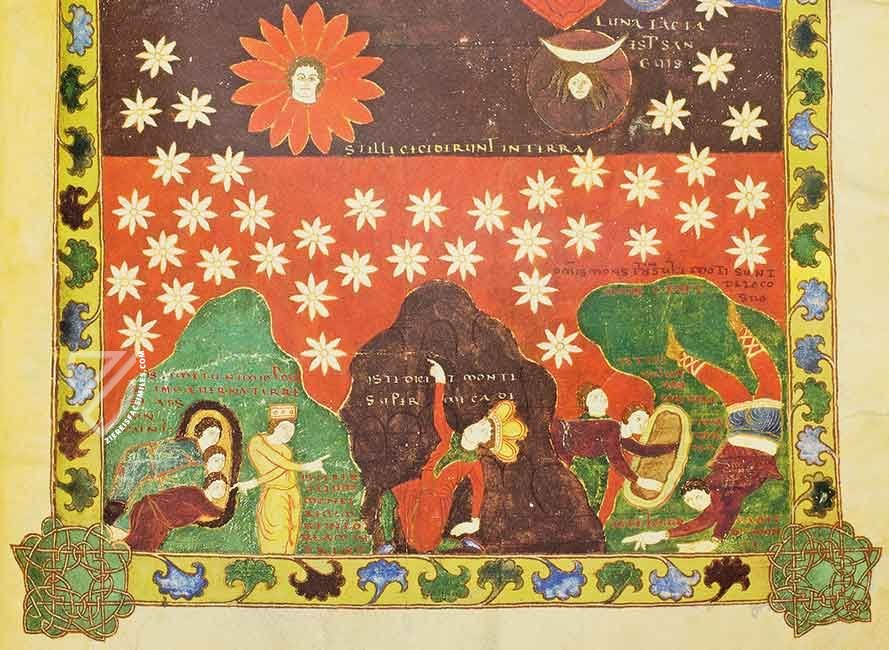
Beatus of Liébana - Saint-Sever Codex
Alpha Page
Aside from the typical Romanesque style, influences from African, Oriental, Insular, and Carolingian art all combine to create the incredible beauty of this Beatus manuscript, the only to originate from France. An unbelievable wealth of colors and forms are presented with gold leaf backgrounds in this 11th century masterpiece.
This monumental Alpha precedes the text of the manuscript. It exemplifies the artistic mix of styles that distinguishes the codex: the letter itself is gold leaf and is adorned of interlace typical of Insular illumination, while the fox, monkey, and shorebirds are harder to pin down stylistically, perhaps a hybrid of styles. The color scheme is typical of the Beatus tradition, mixing dark blue, green, and brown with bright yellow and orange.
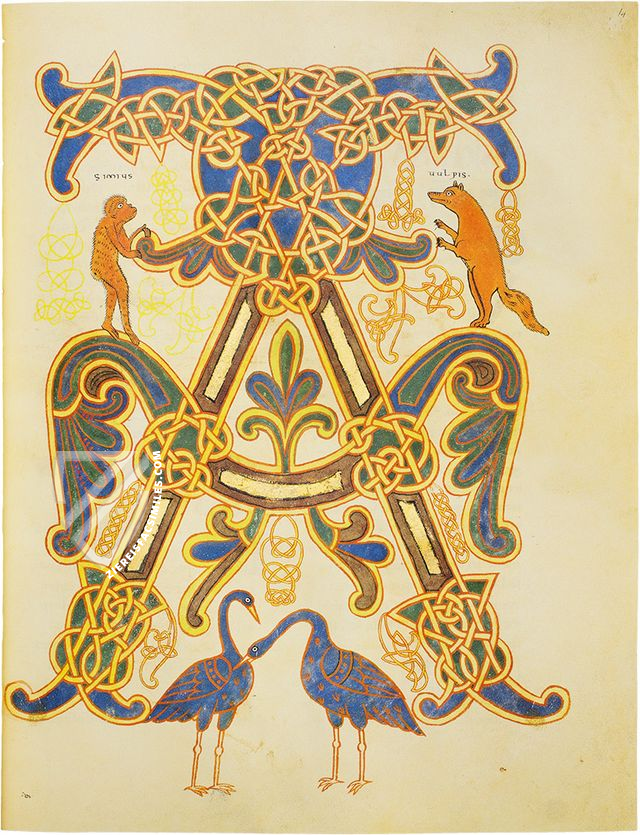
#1 Beato de Liébana: Códice de Saint-Sever ("Pergamenata" Edition)
Languages: Spanish, Italian, English, German
(3,000€ - 7,000€)
#2 Beato de Saint-Sever
Language: Spanish
(3,000€ - 7,000€)
#3 El "Beato" de Saint-Sever
Language: Spanish
(3,000€ - 7,000€)
#4 Beato de Liébana: Códice de Saint-Sever (Gold Edition)
Languages: Spanish, Italian, English, German
(over 10,000€)
- Treatises / Secular Books
- Apocalypses / Beatus
- Astronomy / Astrology
- Bestiaries
- Bibles / Gospels
- Chronicles / History / Law
- Geography / Maps
- Saints' Lives
- Islam / Oriental
- Judaism / Hebrew
- Single Leaf Collections
- Leonardo da Vinci
- Literature / Poetry
- Liturgical Manuscripts
- Medicine / Botany / Alchemy
- Music
- Mythology / Prophecies
- Psalters
- Other Religious Books
- Games / Hunting
- Private Devotion Books
- Other Genres
- Afghanistan
- Armenia
- Austria
- Belgium
- Belize
- Bosnia and Herzegovina
- China
- Colombia
- Costa Rica
- Croatia
- Cyprus
- Czech Republic
- Denmark
- Egypt
- El Salvador
- Ethiopia
- France
- Germany
- Greece
- Guatemala
- Honduras
- Hungary
- India
- Iran
- Iraq
- Israel
- Italy
- Japan
- Jordan
- Kazakhstan
- Kyrgyzstan
- Lebanon
- Liechtenstein
- Luxembourg
- Mexico
- Morocco
- Netherlands
- Palestine
- Panama
- Peru
- Poland
- Portugal
- Romania
- Russia
- Serbia
- Spain
- Sri Lanka
- Sweden
- Switzerland
- Syria
- Tajikistan
- Turkey
- Turkmenistan
- Ukraine
- United Kingdom
- United States
- Uzbekistan
- Vatican City
- A. Oosthoek, van Holkema & Warendorf
- Aboca Museum
- Ajuntament de Valencia
- Akademie Verlag
- Akademische Druck- u. Verlagsanstalt (ADEVA)
- Aldo Ausilio Editore - Bottega d’Erasmo
- Alecto Historical Editions
- Alkuin Verlag
- Almqvist & Wiksell
- Amilcare Pizzi
- Andreas & Andreas Verlagsbuchhandlung
- Archa 90
- Archiv Verlag
- Archivi Edizioni
- Arnold Verlag
- ARS
- Ars Magna
- ArtCodex
- AyN Ediciones
- Azimuth Editions
- Badenia Verlag
- Bärenreiter-Verlag
- Belser Verlag
- Belser Verlag / WK Wertkontor
- Benziger Verlag
- Bernardinum Wydawnictwo
- BiblioGemma
- Biblioteca Apostolica Vaticana (Vaticanstadt, Vaticanstadt)
- Bibliotheca Palatina Faksimile Verlag
- Bibliotheca Rara
- Boydell & Brewer
- Bramante Edizioni
- Bredius Genootschap
- Brepols Publishers
- British Library
- C. Weckesser
- Caixa Catalunya
- Canesi
- CAPSA, Ars Scriptoria
- Caratzas Brothers, Publishers
- Carus Verlag
- Casamassima Libri
- Centrum Cartographie Verlag GmbH
- Chavane Verlag
- Christian Brandstätter Verlag
- Circulo Cientifico
- Club Bibliófilo Versol
- Club du Livre
- CM Editores
- Collegium Graphicum
- Collezione Apocrifa Da Vinci
- Comissão Nacional para as Comemorações dos Descobrimentos Portugueses
- Coron Verlag
- Corvina
- CTHS
- D. S. Brewer
- Damon
- De Agostini/UTET
- De Nederlandsche Boekhandel
- De Schutter
- Deuschle & Stemmle
- Deutscher Verlag für Kunstwissenschaft
- DIAMM
- Droz
- E. Schreiber Graphische Kunstanstalten
- Ediciones Boreal
- Ediciones Grial
- Ediclube
- Edições Inapa
- Edilan
- Editalia
- Edition Deuschle
- Edition Georg Popp
- Edition Leipzig
- Edition Libri Illustri
- Editiones Reales Sitios S. L.
- Éditions de l'Oiseau Lyre
- Editions Medicina Rara
- Editorial Casariego
- Editorial Mintzoa
- Editrice Antenore
- Editrice Velar
- Edizioni Edison
- Egeria, S.L.
- Eikon Editores
- Electa
- Emery Walker Limited
- Enciclopèdia Catalana
- Eos-Verlag
- Ephesus Publishing
- Ernst Battenberg
- Eugrammia Press
- Extraordinary Editions
- Fackelverlag
- Facsimila Art & Edition
- Facsimile Editions Ltd.
- Facsimilia Art & Edition Ebert KG
- Faksimile Verlag
- Feuermann Verlag
- Folger Shakespeare Library
- Franco Cosimo Panini Editore
- Friedrich Wittig Verlag
- Fundación Hullera Vasco-Leonesa
- G. Braziller
- Gabriele Mazzotta Editore
- Gebr. Mann Verlag
- Gesellschaft für graphische Industrie
- Getty Research Institute
- Giovanni Domenico de Rossi
- Giunti Editore
- Graffiti
- Grafica European Center of Fine Arts
- Guido Pressler
- Guillermo Blazquez
- Gustav Kiepenheuer
- H. N. Abrams
- Harrassowitz
- Harvard University Press
- Helikon
- Hendrickson Publishers
- Henning Oppermann
- Herder Verlag
- Hes & De Graaf Publishers
- Hoepli
- Holbein-Verlag
- Houghton Library
- Hugo Schmidt Verlag
- Idion Verlag
- Il Bulino, edizioni d'arte
- ILte
- Imago
- Insel Verlag
- Insel-Verlag Anton Kippenberger
- Instituto de Estudios Altoaragoneses
- Instituto Nacional de Antropología e Historia
- Istituto dell'Enciclopedia Italiana - Treccani
- Istituto Ellenico di Studi Bizantini e Postbizantini
- Istituto Geografico De Agostini
- Istituto Poligrafico e Zecca dello Stato
- Italarte Art Establishments
- Jan Thorbecke Verlag
- Johnson Reprint Corporation
- Josef Stocker
- Josef Stocker-Schmid
- Jugoslavija
- Karl W. Hiersemann
- Kasper Straube
- Kaydeda Ediciones
- Kindler Verlag / Coron Verlag
- Kodansha International Ltd.
- Konrad Kölbl Verlag
- Kurt Wolff Verlag
- La Liberia dello Stato
- La Linea Editrice
- La Meta Editore
- Lambert Schneider
- Landeskreditbank Baden-Württemberg
- Leo S. Olschki
- Les Incunables
- Liber Artis
- Library of Congress
- Libreria Musicale Italiana
- Lichtdruck
- Lito Immagine Editore
- Lumen Artis
- Lund Humphries
- M. Moleiro Editor
- Maison des Sciences de l'homme et de la société de Poitiers
- Manuscriptum
- Martinus Nijhoff
- Maruzen-Yushodo Co. Ltd.
- MASA
- Massada Publishers
- McGraw-Hill
- Metropolitan Museum of Art
- Militos
- Millennium Liber
- Müller & Schindler
- Nahar - Stavit
- Nahar and Steimatzky
- National Library of Wales
- Neri Pozza
- Nova Charta
- Oceanum Verlag
- Odeon
- Orbis Mediaevalis
- Orbis Pictus
- Österreichische Staatsdruckerei
- Oxford University Press
- Pageant Books
- Parzellers Buchverlag
- Patrimonio Ediciones
- Pattloch Verlag
- PIAF
- Pieper Verlag
- Plon-Nourrit et cie
- Poligrafiche Bolis
- Presses Universitaires de Strasbourg
- Prestel Verlag
- Princeton University Press
- Prisma Verlag
- Priuli & Verlucca, editori
- Pro Sport Verlag
- Propyläen Verlag
- Pytheas Books
- Quaternio Verlag Luzern
- Reales Sitios
- Recht-Verlag
- Reichert Verlag
- Reichsdruckerei
- Reprint Verlag
- Riehn & Reusch
- Roberto Vattori Editore
- Rosenkilde and Bagger
- Roxburghe Club
- Salerno Editrice
- Saltellus Press
- Sandoz
- Sarajevo Svjetlost
- Schöck ArtPrint Kft.
- Schulsinger Brothers
- Scolar Press
- Scrinium
- Scripta Maneant
- Scriptorium
- Shazar
- Siloé, arte y bibliofilia
- SISMEL - Edizioni del Galluzzo
- Sociedad Mexicana de Antropología
- Société des Bibliophiles & Iconophiles de Belgique
- Soncin Publishing
- Sorli Ediciones
- Stainer and Bell
- Studer
- Styria Verlag
- Sumptibus Pragopress
- Szegedi Tudomànyegyetem
- Taberna Libraria
- Tarshish Books
- Taschen
- Tempus Libri
- Testimonio Compañía Editorial
- Thames and Hudson
- The Clear Vue Publishing Partnership Limited
- The Facsimile Codex
- The Folio Society
- The Marquess of Normanby
- The Richard III and Yorkist History Trust
- Tip.Le.Co
- TouchArt
- TREC Publishing House
- TRI Publishing Co.
- Trident Editore
- Tuliba Collection
- Typis Regiae Officinae Polygraphicae
- Union Verlag Berlin
- Universidad de Granada
- University of California Press
- University of Chicago Press
- Urs Graf
- Vallecchi
- Van Wijnen
- VCH, Acta Humaniora
- VDI Verlag
- VEB Deutscher Verlag für Musik
- Verlag Anton Pustet / Andreas Verlag
- Verlag Bibliophile Drucke Josef Stocker
- Verlag der Münchner Drucke
- Verlag für Regionalgeschichte
- Verlag Styria
- Vicent Garcia Editores
- W. Turnowski Ltd.
- W. Turnowsky
- Waanders Printers
- Wiener Mechitharisten-Congregation (Wien, Österreich)
- Wissenschaftliche Buchgesellschaft
- Wissenschaftliche Verlagsgesellschaft
- Wydawnictwo Dolnoslaskie
- Xuntanza Editorial
- Zakład Narodowy
- Zollikofer AG

